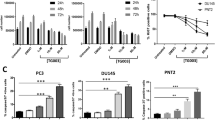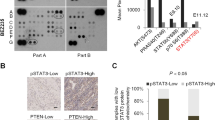Abstract
Phospholipase Cɛ (PLCɛ) is a novel member of phosphoinositide-specific phospholipase C enzymes with a unique regulatory link to Ras GTP-ases. In the present studies, we establish existence of two splice variants (PLCɛ1a and PLCɛ1b) derived from human PLCɛ1 gene. When expressed in COS or HEK293 cells, PLCɛ1a and PLCɛ1b have similar potential to be stimulated by diverse signaling pathways via tyrosine kinase and G-protein coupled receptors and share the ability to function as an effector of Ras. The expression pattern shows broader mRNA expression of PLCɛ1a in normal tissues; furthermore, in most cell lines expressing PLCɛ, PLCɛ1a is the only splice variant present. Analysis of normal/tumor matched pairs derived from colon and rectum demonstrates greatly reduced expression levels in tumor tissues. Further studies in a colorectal tumor cell line lacking PLCɛ show restoration of transcription of PLCɛ1a and PLCɛ1b by demethylating agent 5-aza-2′-deoxycytidine, suggesting epigenetic silencing through hypermethylation. In addition, expression of exogenous PLCɛ in this cell line demonstrates inhibitory effects of PLCɛ on cell viability and proliferation. Taken together, our findings suggest that regulatory mechanisms controlling expression of PLCɛ, broadened by diversity introduced by splice variants, could play important role in PLCɛ regulation in normal and tumor cells.
This is a preview of subscription content, access via your institution
Access options
Subscribe to this journal
Receive 50 print issues and online access
$259.00 per year
only $5.18 per issue
Buy this article
- Purchase on Springer Link
- Instant access to full article PDF
Prices may be subject to local taxes which are calculated during checkout






Similar content being viewed by others
References
Alvarez RA, Ghalayini AJ, Xu P, Hardcastle A, Bhattacharya S, Rao PN, Pettenati MJ, Anderson RE and Baehr W . (1995). Genomics, 29, 53–61.
Berridge MJ, Downes CP and Hanley MR . (1989). Cell, 59, 411–419.
Bogoyevitch MA, Clerk A and Sugden PH . (1995). Biochem. J., 309, 437–443.
Chiloeches A, Mason CS and Marais R . (2001). Mol. Cell. Biol., 21, 2423–2434.
Cox AD and Der CJ . (2003). Oncogene, 22, 8999–9006.
Davies H, Bignell GR, Cox C, Stephens P, Edkins S, Clegg S, Teague J, Woffendin H, Garnett MJ, Bottomley W, Davis N, Dicks E, Ewing RY, Gray K, Hall S, Hawes R, Hughes J, Kosmidou V, Menzies A, Mould C, Parker A, Stevens C, Watt S, Hooper S, Wilson R, Jayatilake H, Gusterson BA, Cooper C, Shipley J, Hargrave D, Pritchard-Jones K, Maitland N, Chenevix-Trench G, Riggins GJ, Bigner DD, Palmieri G, Cossu A, Flanagan A, Nicholson A, Ho JW, Leung SY, Yuen ST, Weber BL, Seigler HF, Darrow TL, Paterson H, Marais R, Marshall CJ, Wooster R, Stratton MR and Futreal PA . (2002). Nature, 417, 949–954.
Downward J . (2003). Nat. Rev. Cancer, 3, 11–12.
Ellis M, James SR, Perisic O, Downes CP, Williams RL and Katan M . (1998). J. Biol. Chem., 273, 11650–11659.
Esteller M . (2003). Adv. Exp. Med. Biol., 532, 39–49.
Evellin S, Nolte J, Tysack K, vom Dorp F, Thiel M, Weernink PA, Jakobs KH, Webb EJ, Lomasney JW and Schmidt M . (2002). J. Biol. Chem., 277, 16805–16813.
Guy M, Moorghen M, Bond JA, Collard TJ, Paraskeva C and Williams AC . (2001). Br. J. Cancer, 84, 520–528.
Hesson L, Dallol A, Minna JD, Maher ER and Latif F . (2003). Oncogene, 22, 947–954.
Jaenisch R and Bird A . (2003). Nat. Genet., 33, 245–254.
Jin TG, Satoh T, Liao Y, Song C, Gao X, Kariya K, Hu CD and Kataoka T . (2001). J. Biol. Chem., 276, 30301–30307.
Katan M . (1998). Biochem. Biophys. Acta, 1436, 5–17.
Kelley GG, Reks SE, Ondrako JM and Smrcka AV . (2001). EMBO J., 20, 743–754.
Kelley GG, Reks SE and Smrcka AV . (2004). Biochem. J., 378, 129–139.
Kim MJ, Min DS, Ryu SH and Suh PG . (1998). J. Biol. Chem., 273, 3618–3624.
Lopez I, Mak EC, Ding J, Hamm HE and Lomasney JW . (2001). J. Biol. Chem., 276, 2758–2765.
Marais R, Light Y, Paterson HF and Marshall CJ . (1995). EMBO J., 14, 3136–3145.
Nagano K, Fukami K, Minagawa T, Watanabe Y, Ozaki C and Takenawa T . (1999). J. Biol. Chem., 274, 2872–2879.
Pfeifer GP, Yoon JH, Liu L, Tommasi S, Wilczynski SP and Dammann R . (2002). Biol. Chem., 383, 907–914.
Pyrzynska B, Serrano M, Martinez AC and Kaminska B . (2002). J. Biol. Chem., 277, 14102–14108.
Rebecchi MJ and Pentyala SN . (2000). Physiol. Rev., 80, 1291–1335.
Rhee S-G . (2001). Annu. Rev. Biochem., 70, 281–312.
Schmidt M, Evellin S, Weernink PA, von Dorp F, Rehmann H, Lomasney JW and Jakobs KH . (2001). Nat. Cell Biol., 3, 1020–1024.
Shayesteh L, Lu Y, Kuo WL, Baldocchi R, Godfrey T, Collins C, Pinkel D, Powell B, Mills GB and Gray JW . (1999). Nat. Genet., 21, 99–102.
Song C, Hu CD, Masago M, Kariyai K, Yamawaki-Kataoka Y, Shibatohge M, Wu D, Satoh T and Kataoka T . (2001). J. Biol. Chem., 276, 2752–2757.
Song C, Satoh T, Edamatsu H, Wu D, Tadano M, Gao X and Kataoka T . (2002). Oncogene, 21, 8105–8113.
Vos MD, Ellis CA, Elam C, Ulku AS, Taylor BJ and Clark GJ . (2003a). J. Biol. Chem., 278, 28045–28051.
Vos MD, Martinez A, Ellis CA, Vallecorsa T and Clark GJ . (2003b). J. Biol. Chem., 278, 21938–21943.
Wells A . (2000). Adv. Cancer Res., 78, 31–101.
Wing MR, Houston D, Kelley GG, Der CJ, Siderovski DP and Harden TK . (2001). J. Biol. Chem., 276, 48257–48261.
Wing MR, Snyder JT, Sondek J and Harden TK . (2003). J. Biol. Chem., 278, 41253–41258.
Wu D, Tadano M, Edamatsu H, Masago-Toda M, Yamawaki-Kataoka Y, Terashima T, Mizoguchi A, Minami Y, Satoh T and Kataoka T . (2003). Eur. J. Neurosci., 17, 1571–1580.
Acknowledgements
We are grateful to T Kataoka for pcDNA3.1GFP-PLCɛ and antibodies to PLCɛ, J Lomasney for pCMVmycPLCɛ, G Kelley for pCMVPLCɛ-Flag, R Marais for pEFmyCRaf and C Marshall for plasmids encoding H-Ras. We would also like to thank N Gandarillas and M Josephs for their valuable assistance. This work is funded by an Institute of Cancer Research studentship to SCS and a Cancer Research UK grant to MK.
Author information
Authors and Affiliations
Corresponding author
Rights and permissions
About this article
Cite this article
Sorli, S., Bunney, T., Sugden, P. et al. Signaling properties and expression in normal and tumor tissues of two phospholipase C epsilon splice variants. Oncogene 24, 90–100 (2005). https://doi.org/10.1038/sj.onc.1208168
Received:
Revised:
Accepted:
Published:
Issue Date:
DOI: https://doi.org/10.1038/sj.onc.1208168
Keywords
This article is cited by
-
PLCε regulates prostate cancer mitochondrial oxidative metabolism and migration via upregulation of Twist1
Journal of Experimental & Clinical Cancer Research (2019)
-
PLCε signaling in cancer
Journal of Cancer Research and Clinical Oncology (2016)
-
Association between novel PLCE1variants identified in published esophageal cancer genome-wide association studies and risk of squamous cell carcinoma of the head and neck
BMC Cancer (2011)
-
Epac: effectors and biological functions
Naunyn-Schmiedeberg's Archives of Pharmacology (2008)
-
Positional cloning uncovers mutations in PLCE1 responsible for a nephrotic syndrome variant that may be reversible
Nature Genetics (2006)



